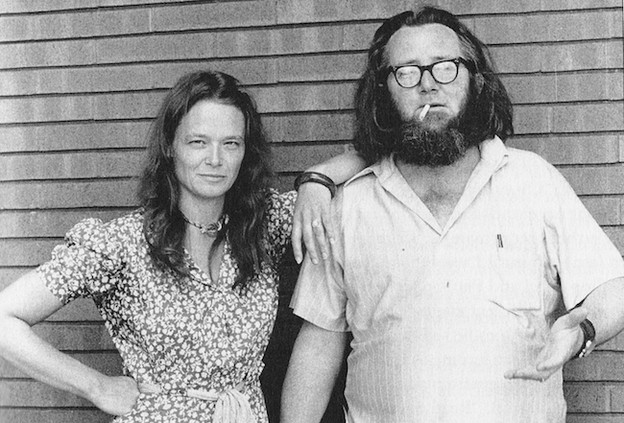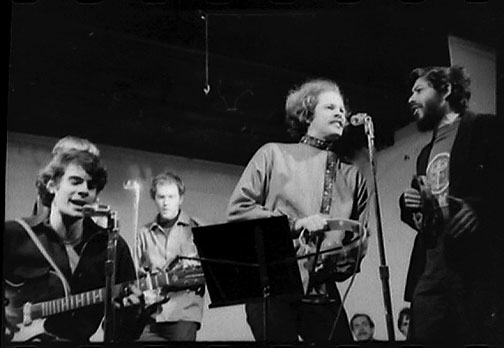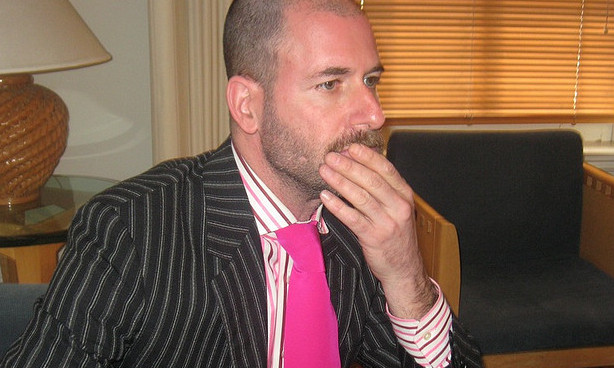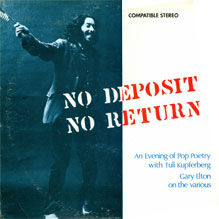 |
| Anne Waldman and Ted Berrigan at the Naropa Institute, 1976. |
We're staying in New York City for our second day on poetry in performance, and while the time period's the same, we're shifting aesthetic tribes from the Fluxus-inspired performance poetry scene to look at two poets who came to prominence as part of the New York School's later permutations: Anne Waldman and Hannah Weiner.
We begin with "Memorial Day," a collaborative work by Waldman and Ted Berrigan written especially for a joint reading at the St. Mark's Poetry Project in May 1971. You can listen to their sole performance of the poem in its entirety here [MP3] and read more about the poem (and the convoluted history of this lost and recovered recording) here. I've also chosen a small group of poems by Waldman that demonstrate that while performance considerations have been a key part of her poetics from the very beginning, her approach to form and the poem's appearance on the page have evolved over her long career. The first five poems are from 1970's Baby Breakdown, while the remainder are from her selected poems, Helping the Dreamer, and date from the 70s and 80s. Certainly, the voice remains an important center in Waldman's writing in the 21st century (cf. more recent poems like "Rogue State": MP3).
Selected poems by Waldman: [PDF]
- "Hi Everyone!"
- "Non Stop"
- "* Baby Breakdown *"
- "Night Poem"
- "* & Now It's Time *"
- "Fast Speaking Woman" [excerpt: MP3]
- "Mirror Meditation"
Waldman reads from "Fast Speaking Woman"
Waldman's New Wave anti-nukes pop song, "Uh Oh, Plutonium"
Moving forward just a few years, we'll take a look at the work of Hannah Weiner (right), who emerged in the cusp between the New York School's second and third generations, but ultimately aimed for a different aesthetic, starting with Mac Low-esque performance pieces and staged happenings before moving into forms that prefigured Language writing of the mid-to-late-70s, specifically her "clairvoyant" style (in part originating in her schizophrenia) through which she experienced aural and visual hallucinations of words and phrases that she transcribed into poetry. To authentically render these multi-vocal texts, Weiner had to devise unique styles of layout, making use of all-caps text and italics, along with super- and sub-scripts. First, we'll take a look at a few pieces from the marvelous Hannah Weiner's Open House: [PDF]
- "Hannah Weiner at Her Job"
- from Code Poems: "Romeo and Juliet" (see below)
- "The words in CAPITALS..." (an explanation of Weiner's "clair-style")
- "The Zero One"
- "Radcliffe Women and Guatemalan Women"
Then, from her best known work, Clairvoyant Journal we'll look at excerpts from March and April — you'll find a reproduction at the link above — which correspond to recordings of these sections performed by Regina Beck, Sharon Mattlin, Peggy De Coursey, and Hannah Weiner released on a 1978 New Wilderness Audiographics cassette: March [MP3] / April [MP3].
Additionally, you can watch a performance of "Romeo and Juliet" by Kaplan Harris, Rodrigo Toscano, and Laura Elrick about a third of the way through the first video on this page.










